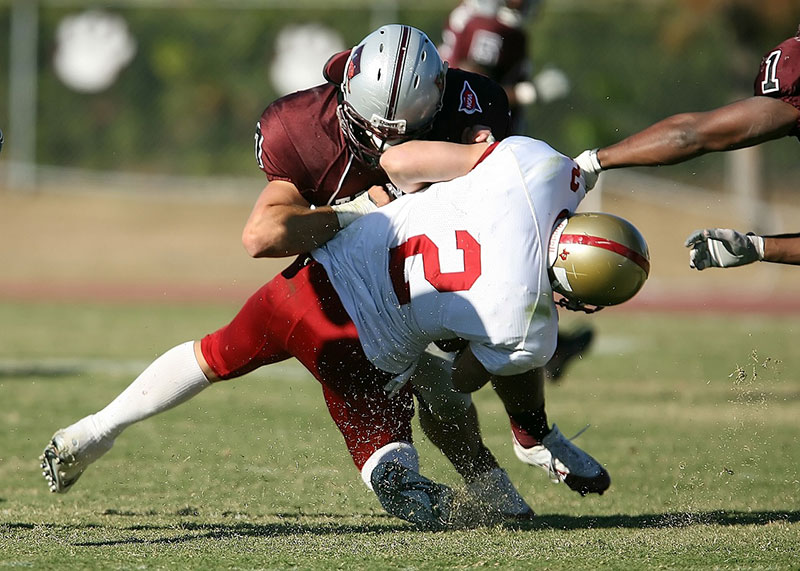What are the most common injuries in football? 4 common injuries

In the world of football, every yard gained and every touchdown scored is a story of triumph and teamwork.
Yet, for those sidelined by injury, the story is different. It’s the silent battle off the field – watching teammates push through while you’re caught in the grip of recovery, the longing to feel the grass beneath your cleats and the ball in your hands.
It’s more than physical pain; it’s the emotional ache of missing the laughter with your teammates, the thrill of competition, and the personal growth that comes with each practice and game.
This article is for those who know this struggle and for those who want to prevent it.
In this article, you dive into what causes football injuries and explore the most common ones that players face, with insights on prevention and recovery.
Understanding Football Injuries
Football injuries are as varied as the game itself, often a result of high-speed impacts, rapid direction changes, and the immense physical demands of the sport.
Understanding these injuries involves looking at the mechanics of the game – how a sudden tackle can jar the body, how repetitive motions can strain muscles, and how the intensity of the game can push the body to its limits.
Let’s explore those common injuries…
4 Most Common Football Injuries
Concussions
For many of you hitting the field, the risk of a concussion is a real concern. This isn’t just about the immediate hit; it’s about your future, both on and off the field.
Concussions occur with sudden and forceful impacts – something not uncommon in football. These traumatic brain injuries occur when a player sustains a significant blow to the head or body, leading to a rapid movement of the brain inside the skull.
Effects of Concussions:
Concussions can lead to a range of symptoms, from headaches and dizziness to cognitive and emotional disturbances.
The long-term effects can be even more concerning, with potential risks of chronic traumatic encephalopathy (CTE) in severe or repeated cases.
Prevention Strategies:
- Proper Tackling Technique: Emphasize keeping the head up and not leading with the helmet. Safe tackling reduces the risk of head collisions.
- Quality Helmets: Use helmets that meet current safety standards and fit correctly. While no helmet can prevent concussions entirely, proper equipment can mitigate impact forces.
- Awareness and Education: Players, coaches, and parents must be educated about concussion symptoms and the importance of reporting and addressing them immediately.
ACL Tears
The Anterior Cruciate Ligament (ACL) is crucial for knee stability, particularly in a sport that demands rapid direction changes. ACL tears often happen during sudden stops or changes in direction, as well as from awkward landings or collisions.
Long-term Impact: An ACL tear can lead to extended time off the field and, if not properly rehabilitated, can increase the risk of osteoarthritis in the knee.
Exercises for Prevention:
- Hamstring and Quadriceps Strengthening: These muscles support the knee joint. Exercises like leg curls and quadriceps sets can build strength.
- Plyometric Training: This helps improve neuromuscular conditioning and knee stability. Include exercises like jump squats and box jumps.
- Balance Training: This enhances proprioception, which is critical for knee stability. Try exercises like single-leg balances and Bosu ball workouts.
Shoulder Injuries
You rely on your shoulders for nearly every move you make on the field – from blocking to throwing.
Shoulder injuries, therefore, aren’t just setbacks; they can fundamentally change how you play the game.
Shoulder injuries in football can range from dislocations to rotator cuff tears, often caused by direct impacts or overuse.
Consequences:
These injuries can severely limit a player’s ability to perform essential movements, like throwing or tackling, and can lead to chronic pain or instability if not properly addressed.
Preventive Exercises:
- Rotator Cuff Strengthening: Exercises like internal and external rotation with bands can bolster these crucial muscles.
- Scapular Stabilization: Workouts focusing on the muscles around the shoulder blade, like scapular push-ups, are beneficial.
- Flexibility: Maintain shoulder flexibility through stretches to decrease the risk of overuse injuries.
Ankle Sprains
Ankle sprains are frequent in football due to the sport’s dynamic movements, including rapid pivots and lateral cuts.
They occur when the ligaments in the ankle are overstretched or torn.
Effects on Mobility: A sprained ankle can result in swelling, pain, and limited range of motion, impacting a player’s agility and speed.
Preventive Strategies:
- Agility Training: Drills that improve footwork and coordination can help in avoiding awkward ankle positions.
- Proprioceptive Exercises: Exercises like standing on one foot or using a wobbleboard enhance the ankle’s ability to stabilize and react to uneven surfaces.
- Strength Training: Focusing on the muscles supporting the ankle, such as calf raises and toe curls, can provide additional stability.
By understanding these common injuries, their causes, effects, and prevention strategies, players can take proactive steps to stay healthy and perform at their best on the field.
